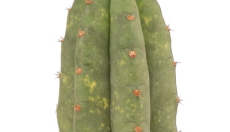How to grow San Pedro cactus
Posted under: How to's

The San Pedro cactus is a columnar cactus native to Ecuador and Peru. The Trichocereus Pachanoi is best known for its mescaline content and its fast growth rate of up to 30 cm per year. Growing San Pedro cactus from seeds can be challenging, but it's possible. To help you grow your own San Pedro cactus at home, I have written a guide that will provide you with the necessary information. Remember, when the growing gets tough, the tough get growing!
Growing Options for San Pedro Cactus
Let's explore your options for growing San Pedro cactus from scratch. The first option is to grow San Pedro from seeds, which can be difficult, but rewarding. The second option is to grow or further grow your cactus from a San Pedro cutting. The third option is to purchase a San Pedro cactus and keep it alive. The pros and cons of the first two options are outlined below. A section on taking care of your San Pedro will cover the rest.
The goal for all San Pedro growing options are the same : To grow a healthy San Pedro cactus and let is flourish to full mescaline wisdom :)
Growing San Pedro from Seeds: Pros and Cons
Many people have done it before you. You need to have some patience, but the rewards are high! It is rewarding seeing it grow, you did that, with your own hands! Think of the energy and love you San Pedro can absorb and will give back in the end.
I know it is a Dutch argument, but growing from seed it is cheap! Seeds of the San Pedro can be bought in several locations. Can be stored for years and grow when you want. They are cheaper then a cutting or a potted San Pedro. The best part is that you can have multiple cacti when more seeds sprout.
The most challenging part of growing San Pedro from seeds is germinating them and taking care of the tiny cacti in the first stages. It's possible that some seeds may not sprout, and overwatering can kill the small San Pedro. Once you get past this stage, you and your mescaline cactus will thrive.
Growing San Pedro with a Cutting: Pros and Cons
The second option is to grow San Pedro with the help of a San Pedro cutting. It may feel like cheating, but it's a common practice. It avoids the hardest part of growing your own San Pedro cactus, which is germinating the seeds and growing the tiny San Pedro cacti.
To grow San Pedro from a cutting, you can order a healthy San Pedro cutting from a reputable source or obtain it from someone who has a good source. Growing from a cutting takes less time, and multiple San Pedro cacti can grow from a single cutting.
How to grow San Pedro cactus
If you are interested in growing San Pedro cactus, here are some basic steps:
- Obtaining a San Pedro cactus cutting: San Pedro cactus is typically propagated by cuttings, which can be obtained from a reputable cactus nursery or online retailer. You can also get cuttings from a friend or acquaintance who already has a San Pedro cactus.
- Preparing the cutting: Once you have obtained a cutting, allow it to dry for a few days to a week to prevent rotting. You can do this by placing it in a dry and shady spot. After it has dried, cut off any remaining flesh at the base of the cutting.
- Rooting the cutting: Once the cutting has dried, you can root it in a well-draining soil mix, such as a cactus mix. You can also use a rooting hormone to promote root growth. Place the cutting in the soil mix and water it sparingly, about once a week or when the soil is completely dry. It is important to avoid overwatering, as this can cause the cutting to rot.
- Growing the cactus: Once the cutting has rooted and started to grow, you can gradually increase the amount of water and light it receives. San Pedro cactus prefers a sunny and warm location, with well-draining soil and occasional fertilization. It can take several years for the cactus to reach a size suitable for harvesting mescaline-containing tissue, so patience is key.
It is important to note that San Pedro cactus contains a psychoactive compound and should be used responsibly and with caution.


February 27, 2023